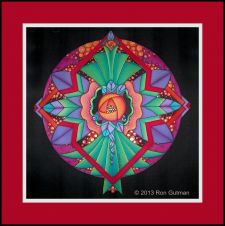Silk Painting How to
How to Categories
• Tips
How to Use Resistad
What is Resistad? Resistad is a popular non toxic water-based resist.
Three concentrates are available: thin, medium and thick.
MEDIUM RESISTAD is recommended for painting on silk with dyes.
MEDIUM RESISTAD converts steam-fix liquid dyes and plain water into guttas of suitable viscosity for hand pipette application, brush painting, stamping, and block printing. (Clear, dye-colored, full strength or pastel).
Preparation
Recipe: 1 part LIQUID STEAMFIX DYE OR WATER - plus - 1 part MEDIUM RESISTAD (50/50)
Heat setting
Heatset the gutta design in the following ways (in diminishing order of heat setting efficiency).
ProColour Notes: Transforming the Resistad gutta from being water based into being water resistant requires heat. Ironing changes the nature of Resistad gutta lines, from water based into water repellent. Iron thoroughly - it’s very easy to miss or under-do part of a painting.
Do not set iron heat too high or the Resistad will discolor and become difficult to remove.
The efficiency of the heatsetting of Resistad guttas determines the “resistivity” of the gutta. If the gutta has been given optimum heat setting, then it will shrug off dye almost as well as wax does.
Overpainted dye will bead up on top of well heat set gutta where it can be dabbed dry with a cotton bud. If the heat setting is mediocre, then the gutta can be overpainted with dye and it will behave more like an antifusant towards the dye.
You may need an extra heat setting: If the Resistad has been colored with dark steam¬-fix dye (i.e. black), the dye inside the gutta is unfixed and when wet dye touches the gutta line edges it redissolves particles of dye on the line edge, and spoils the sharpness of the gutta outline. To fix this problem the only remedy is to steam fix the gutta outline design prior to coloring in this design with dye. After steam fixation, the fill dye then cannot redissolve the dye inside the gutta because it’s fixed. (See Linda M note below)
Use of a clothes dryer is discouraged if the gutta has been colored with dye. The dye particles could contaminate the dryer and effect future dryer loads.
Color, fix, rinse
ProColour Notes:
Shared experiences from SPIN members
John Mitchell (ProColour)
Alcohol free dyes are best to add to the Resistad for colored line work. The reason for this is that all natural thickeners cannot mix with and therefore thicken alcohol, so it tends to leak out the edges of the linework and spoils sharp definition. So if you're making any sort of print paste, omit alcohol or risk poor design definition. This rule is for ALL THICKENERS...sodium alginate, gum arabic, guar gum, carob and rice flour etc.
Resistad is not toxic, … but it's always good to store any non food items in labeled airtight containers that in no way resemble any food items also in the fridge.
Ron G
Do not exceed the recommended 50/50 proportions when mixing & mix very well, work on a well stretched/taut silk with slight pressure to insure even penetration, heat set before painting (I use a hot dry iron right on the stretched piece). For line work you want 'medium' Resistad...each of the 3 types serve their own purpose. Store in refrigerator.
After steaming the Resistad will easily wash out in the rinse. It is best to color the Resistad with a non-alcohol based dye as the alcohol can weaken the holding power of the resist. I use Jacquard dyes for tinting the Resistad. However, once you have heat set it, there is no problem with using alcohol based dyes to paint with.
Linda M I apply it to the silk using an Air Pen applicator with a small compressor. I also use it by coloring it with dye and painting it directly on the silk as a thickened dye, or by using a Pro-liner with a metal nib.
If it is painted on covering large areas it does slightly alter the silk’s hand. It can be used to do block printing, direct painting, and very fine line work. When diluted to a very weak strength it can be used as an anti-diffusant, it can be sponged on the silk to create leaves on trees or textures.
There are 2 ways to set the Resistad before you apply the dyes. Heat setting with an iron or hair dryer or steaming. Since I use black Dupont dye to color most of my lines I double steam the Resistad to keep the black dye from bleeding into lighter colors because Dupont black is very erosive to the Resistad. Other dyes may not have the same effect so experiment.
|
Blue Feather Rose, using Resistad, by Ron Gutman |
